SYNOPSIS
! SPOILER ALERT !
IRON MAN
Continued from Tales of Suspense
#87, where the Mole Man used a device to
cause the ground beneath the Stark
Industries factory to cave in and the
building to sink into the ground, thus
enabling him to capture an atomic powered
"earth borer"...
Iron Man, who was in one of the now
collapsed buildings, now discovers that
Pepper Potts was also in the factory, and
they both soon find themselves attacked
by the Mole Man's Moloids.
As comic book villains are apt to do,
the Mole Man explains his intentions at
great length, giving Iron Man enough time
and wiggle room to fight off the Moloids.
However, the Mole Man then unleashes a
fire breathing dragon and, while Iron Man
fights off this beast, kidnaps Pepper and
takes her back to the boring device.
When Iron Man (having defeated the
creature) catches up with them again, the
Mole Man orders him to show him how the
boring device works in exchange for
Peppers life. Iron Man uses a ruse and
actually instructs the Mole Man how to
cause the device to overload and explode,
escaping with Pepper just before all is
blown up, seemingly killing the Mole Man
in the process.
SYNOPSIS
! SPOILER ALERT !
CAPTAIN AMERICA
At Avengers Mansion, Captain America
receives a distress call from somebody
who appears to be Bucky, telling him that
he's been a prisoner for all these years
on a remote island. Cap races off to the
rescue of his trusted WWII sidekick, not
knowing that he is being lured straight
into a trap, with the Swordsman and Power
Man having been recruited to face off
against Captain America upon his
arrival...
When Captain America arrives on the
remote island he quickly realizes that in
order to save Bucky's life he first has
to battle it out with both costumed
villains. He defeats both of them easily
but then finds himself trapped in what
seems to be an indestructible transparent
bubble.
As Cap is struggling but essentially
helpless, the villain who employed the
Swordsman and Powerman reveals himself.
The story continues on from this
cliffhanger in the next issue, where
readers will learn that it is the Red
Skull who has trapped Captain America...
|
|
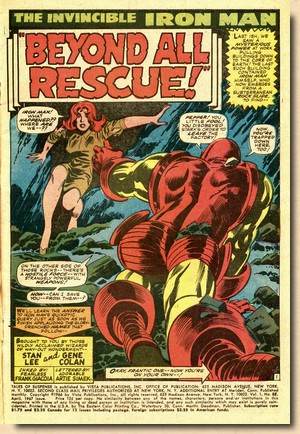 
|
|
|
| |
| |
REVIEW
& ANALYSIS
In 1966, Tales of Suspense was
one of Marvel's so-called two-feature
titles - a comic book essentially shared by two
different starring characters in their own stories. They
were a staple of Marvel Comics for several years
throughout the 1960s, but the format wasn't the result of
a voluntary decision.
|
| |
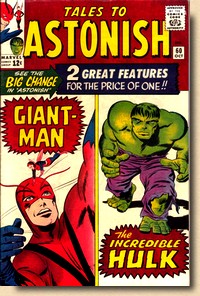 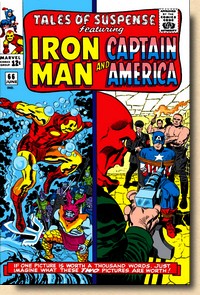
|
|
The need
to split one comic book between two main
characters actually had its roots back in
1957, when Martin Goodman's new choice of
distributing company for his comics,
American News Company, went out of
business unexpectedly. The fallout for
Goodman and his Atlas Comics was that
they found themselves with no other
choice than to switch to Independent News
as distributor. The snag: unlike what the
name suggested, Independent was in fact
owned by National Periodical - who also
happened to own Goodman's rivals DC
Comics. The
well-known outcome of this was that Atlas
and then Marvel Comics was limited by
contract to a monthly publishing output
of eight titles only (Cooke, 1998). As
a result, Stan Lee juggled with a mix of
bi-monthlies, cancelling Romance and
Western titles, and turning Horror books
into Superhero titles - all in order to
get the distribution slots freed up for
what was selling: Marvel Comics' brand
new and different approach to the genre
featuring "superheroes in the real
world".
Once the old Atlas horror and mystery
titles had been given over to Marvel's
new superheroes (albeit retaining their
original titles), yet another way of
approaching the limited distribution
problem was the two-feature title.
This formula had already been
successfully tested since Strange
Tales #110 (July 1963) when Doctor
Strange joined the Human Torch (who would
later be replaced with Nick Fury as of
issue #135, August 1965). In late 1964 Tales
to Astonish became a split book too,
with issue #60 (October 1964) featuring
the Hulk and the previous solo star
character Giant-Man (replaced by Namor
the Sub-Mariner as of issue #70) in
separate stories. Iron Man followed suit
and began to share his Tales of
Suspense a month later with Captain
America (issue #59, November 1964).
Marvel Comics finally
broke free from the distribution
constraints in 1967 when Independent was
purchased by Kinney National Company and
they got a new deal. The result was an
explosion of new titles as established
characters finally could be given their
own comic book - Tales
of Suspense, Tales to Astonish and
Strange Tales alone split to become
six titles instead of three.
By the time Tales of Suspense
#88 hit the newsagent stands the Iron Man
and Captain America double-bill was well
established, and the two superheroes took
turns for cover appearances (after the
two-feature titles dropped the initial
"split-cover formula" as seen
above with Tales of Suspense
#66.
|
|
|
| |
| This would last until Tales of Suspense #99
(March 1968), as the two heroes got their own titles
after that - Iron Man went on to feature in Iron Man
& Sub-Mariner #1 and then a month later in Iron
Man #1, whereas Cap took the numbering with him and
started out in Captain America #100. Iron Man
would always come first (Tales of Suspense was,
after all, "his" original title), and in this
issue his story starts out with a classic Gene
Colan splashpage, highlighting the underlying
vulnerability of Marvel's superheroes. The unfolding
events (still plotted by Stan Lee himself at the time)
feature more of Colan's breathtakingly dynamic and
cinematographic artwork, which worked well with Frank
Giacoia's inks. Two masters at work.
|
| |
|
| |
| The following Captain America story, again scripted
by Stan Lee, was pencilled by another industry great: Gil
Kane. Born Eli Katz in 1926 in Riga, Latvia, he emigrated
to the US with his family in 1929 and grew up in
Brooklyn, where he developed an early interest in comic
books and landed his first job with MLJ (later Archie)
Comics in 1942. At the age of only 16, he left school in
order to be able to continue what had started out as a
summer job (Groth, 1996). He used the name "Gil
Kane" to sign his first inking work in MLJ's Zip
Comics #14 (May 1941) and subsequently stuck with it. |
| |

Gil Kane
(1926 - 2000)
|
|
His first work
for what would later become
Marvel Comics featured in Young
Allies #11 (March 1944),
followed by uncredited ghost
artist work for Jack Kirby in
DC's Adventure Comics #91
(May 1944). Following highly
influential work for DC in the
Silver Age superhero revival
(e.g. Green Lantern), Kane also
worked on a number of Marvel
titles in the 1960s. He would
eventually not only become the
regular penciller for The
Amazing Spider-Man in the
early 1970s, but also Marvel's
preeminent cover artist
throughout that decade.
|

|
|
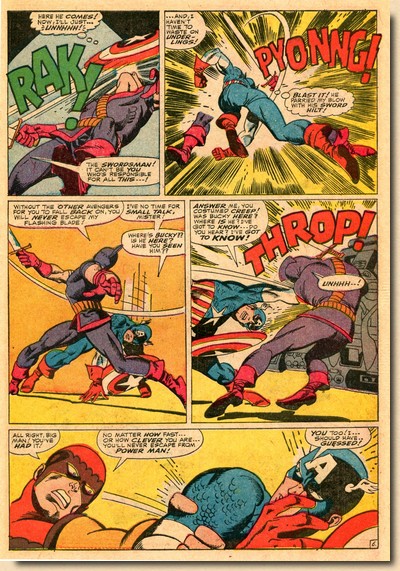 |
|
|
| |
| Gil Kane is especially remembered for his gripping
rendering of the story arc depicting the deaths of both
Gwen Stacy and the Green Goblin (Amazing Spider-Man
#121–122, June–July 1973). At that time,
sacrificing two high profile characters without a back
door to bring them back to life was highly unusual
(comparable really to Hitchcock shocking moviegoers in
1960 with the violent death of his female leading actress
Janet Leigh after only 47 minutes into Psycho),
and Kane's pencils suited the dramatic events well. His
artwork can truly be labelled classic mid-1960s to late
1970s and embodies what most comic book fans of that era
would describe as the kind of artwork that typifies what
they liked about comic book art: a dynamic approch to the
action of the story and a clear focus on the characters
involved (which could sometimes result in simple or no
backgrounds at all, as illustrated by the panels from Tales
of Suspense #88 shown here). |
| |
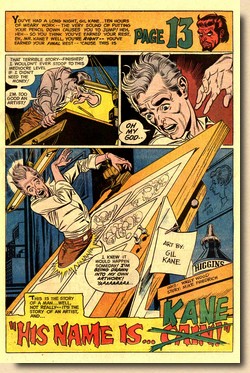
House
of Mystery #180 (June 1969)
|
|
Gerry Conway (who
scripted the famous Amazing
Spider-Man #121–122 issues)
described Kane as "a marvelous
draftsman and an idiosyncratic
storyteller" while also noting
that unless given a tighter plot (which
Kane himself preferred) his work "could
sometimes result in lopsided
storytelling; the first two-thirds of a
story would be leisurely paced, and the
last third would be hellbent-for-leather
as Gil tried to make up for loose
storytelling". (Conway in
Buchanan, 2009). It just goes to show
that comic books are always a team
effort. With writer Roy Thomas, Kane
helped revise Marvel's Captain, revamped
a preexisting character as Adam Warlock,
and co-created martial arts superhero
Iron Fist as well as Morbius the Living
Vampire.
Gil Kane is also remembered for one of
the most extraordinary cameos in comic
book history, being made the lead
character in writer Mike Friedrich's
story "His Name Is... Kane" in
DC's' House of Mystery #180 (June
1969). In this six-and-a-half-page tale,
pencilled by Kane himself, frustrated
comic-book artist Gil Kane kills his House
of Mystery editor, Joe Orlando - but
Orlando, himself an artist, then goes on
to enact revenge by drawing Kane into
artwork that is then framed and mounted
in the house, thus trapping him there.
Kane remained active as an artist,
also illustrating paperback novel and
record album covers, until his death in
January 2000.
|
|
|
| |
| |
LIFE'S
A SWINGIN' SYMPHONY - 'NUFF SAID!
|
| |
| An absolutely integral part of being a Marvel Comics
reader and fan in the 1960s and 1970s were the letters
pages (aptly titled "Mails of Suspense" in this
case) and the monthly Bullpen Bulletin. |
| |
These were the gathering
points for all "true
believers", where opinions amongst
readers as well as informations from the
House of Ideas as well as directly by
Stan the Man himself were handed out, and
they made you feel that you were a part
of something special - and sometimes fans
would check out these pages even before
reading the actual story material in the
comic book they were holding.
"As
a mad Marvelite, you're more than
just a reader - you're a friend! So
drop me a line soon as you can, I'll
be waiting, hear?" (Lee,
1972)
It was, of course, all by design, and
one of the major elements which so
successfully set Marvel apart from DC.
"What
I always tried to do with Marvel was
to make it seem like a club, like an
inner group that we knew about and
the outside world wasn't even aware
of. If you read Marvel you were on
the inside, you were hip, and it was
sort of an exclusive thing, limited
just to Marvel readers. And I tried
to talk to the readers as if they
were friends, not readers, so that
not only - hopefully - did they enjoy
the stories, but they enjoyed being
part of the Marvel mystique if you
might say, and I'm probably making it
sound much more profound than it
really was, but that's the way I
looked at it.
|
|
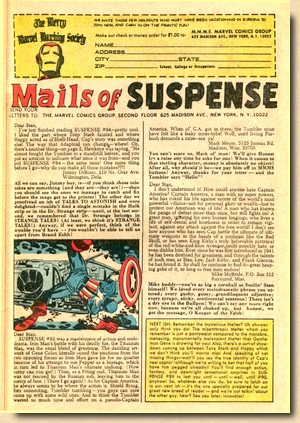 |
|
|
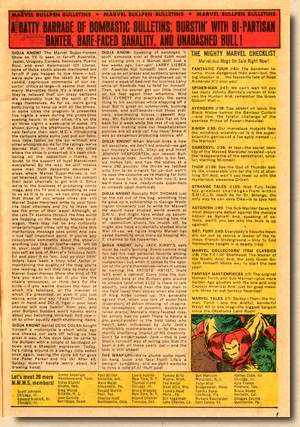 |
|
I wanted
people to be aware of Marvel, and I
wanted people to know about the
mysticism and the magic and
marvelness of Marvel, and they say
that if you build a better mousetrap
the world will beat a path to your
door, but the world will only do that
if it knows the mousetrap exists, and
I didn't want us to be doing these
books in a vacuum, because you know
comic books had no advertising
budget, no promotion. There were no
ads on television, on the radio, in
newspapers - you just printed your
comic book and it was out there, and
I was sort of like Joan of Arc, I was
on a crusade, a mission, to let the
world know about the marvelous world
of Marvel. So in that sense, I guess
I was a little bit of a
huckster." (NN, 2003)
The
"mysticism
and magic and marvelness" of Marvel
was of course echoed (as always somewhat
tongue-in-cheek) by the famous
alliterations Stan came up with as titles
for the monthly Bullpen Bulletins.
These initially started out as part of
the two-page letters section of Fantastic
Four, which often concluded with a
"Special Announcements Section"
where Stan Lee responded to more general
letters and promoted other Marvel titles.
A vital element - "The Mighty Marvel
Checklist" - appeared for the first
time in this Special Announcements
Section in Fantastic Four #33
(December 1964). A separate "Merry
Marvel Bullpen Page" appeared in
comics cover-dated July and August 1965
(with the checklist and special
announcements still on the letters
pages), and the first stand-alone
"Marvel Bullpen Bulletins"
page, complete with checklist and special
announcements, finally made its debut in
the issues cover-dated December 1965.
|
|
|
| |
The Bullpen Bulletin was thus still a fairly new
concept to readers of Tales of Suspense #88, and
"Stan's Soapbox" - another pivotal element of
Marvel's editorial page - was still more than a year out,
first appearing in the June 1967 issues. In the April
1966 Bullpen Bulletin, Stan touched on Marvel's TV shows
going international, Gene Colan's mishaps with his new
motorcycle as well as medical problems suffered by Larry
Lieber and Bill Everett (after all you want to know
what's going on with your friends), complete with a
little sting directed at Brand Echh (i.e. DC Comics)
suggesting they were into voodoo to hamper Marvel's
bullpen of creators, and more personal news concerning
the hiring of John Verpoorten, Roy Thomas forsaking
University for Marvel Comics, and Jack Kirby being fellow
artists' choice for best artist (or, as Lee would put it
in his self-caricaturing way, "pencil pusher").
Stan Lee wrapped it all up with one of his typically
upbeat and avuncular messages to readers:
"We're plumb outta room, so hang loose
and face front! Life's a swingin' symphony, and we
don't wantcha to miss a note of it! 'Nuff said!"
|
| |
| |
FACTS
& TRIVIA
|
| |
| Tales Of Suspense #88
went on sale in the US on 1 October 1966 and was also
made available roughly three months later to the UK
market with a pence price variant cover. |
| |
 |
|
The Captain America story
was reprinted in Marvel Double
Feature #12 (October 1975), a Marvel
reprint title focussed on Tales
Of Suspense, together with the Gil
Kane cover. Typical for Marvel's
mid-1970s reprint titels, the Cap story
lost 2 pages and the cover received some
alterations to the colouring (actually
making it more consistent with the
colouring of Power Man's suit in the
actual story). Somewhat confusingly,
however, the Iron Man story had already
been reprinted (again leaving out two
pages) in Marvel
Double Feature #5 (August 1974); the
Iron Man story featured in Marvel
Double Feature #12 was taken from Tales
of Suspense #95 (November 1967).
While the cover has been
reprinted multiple times in Marvel's
various collected editions (Essentials,
Masterworks, Omnibus editions), it was
also used by international publishers.
Italian Editore Corno did
so no less than twice, for their Capitan
America #11 (1973) and Capitan
America Gigante #5 (1980). Mexican
publishers La Prensa adorned their Capitán
América #3 (1968) with Kane's
wonderful cover, as did Panini España
for their Marvel Gold: Capitán
América #1 (2011).
|
|
|
| |
| Although many readers at the time probably had little
to no interest in the small print Statement of
Ownership, Management, and Circulation which appeared
once every 12 months in the pages of their comic books,
they provide us with some interesting statistics
regarding print runs, actual sales, and subscription
numbers. Tales Of Suspense #88 contains
such a Statement. These had been required of publishers
who shipped their printed matters Second Class since the
19th Century, but as of
1960 they were also required to list their average paid
circulation for the past twelve months. |
| |
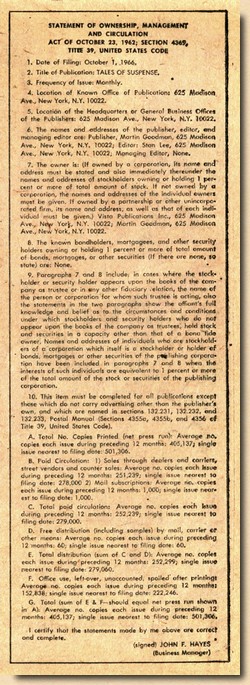 |
|
Printed sideways (so that if you
wanted to read it you had to turn your comic book
around 90 degrees) and in the smallest possible
of fonts, the Statement contained in Tales Of
Suspense #88 tells us that the title had an
average print run of 405,137 copies during the
preceding 12 months (although the issue nearest
to the filing date had a print run of 501,306
copies). Of this average print run of 405,137
copies during the preceding 12 months, 251,239
copies had been sold through dealers, carriers,
street vendors and counter sales; 1,000 copies
had been sold through subscriptions. This
averaged a total paid circulation of 252,299
copies (up to 279,060 copies for the issue
nearest to the filing date) - which left an
average of 152,838 copies counted as "left
over, unaccounted, spoiled after printing".
That's a whopping 38% of the entire print run not
generating revenue, but actually still a lot
better in comparison to later years when this
figure could even go up and above 50%. The
traditional distribution channels for comic books
were increasingly fraught with problems and would
ultimately prove to become untenable, leading
into the so-called direct market.
My personal copy of Tales Of Suspense #88
also illustrates another aspect of comic books at
the time: the care taken to produce this cheap
product at the printers could sometimes be
lacking, and in this case the stapling is way off
the centre line of the folded pagesheet. Such
copies would later on not grade highly and would
become popular items to have an artist involved
sign at conventions (witness Gil Kane's signature
on this specific copy) in order to raise its
value.
|
|
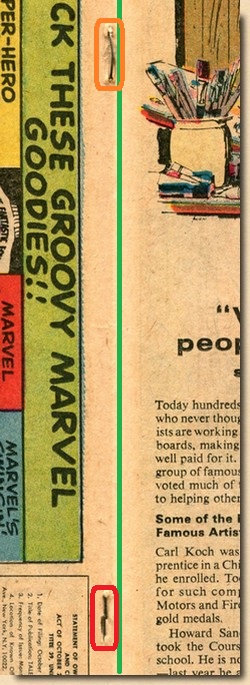 |
|
| |
| No 1960's (and 1970s) Marvel comic book was, of
course, without third party advertising, some of which
was "okay" (mostly if it featured Marvel
characters) and some of which was, well, something else
(such as the infamous flea market ads promising anything
and everything). Tales Of Suspense #88 really
featured it all. Very noticeable is the amount of ads
promising "from home training" in all kinds of
trades, along with a full page ad offering a "second
chance for High School dropouts to get diplomas".
Are we therefore to assume that the Academy of Home
Study assumed that a substantial number of their
target customer base was to be found amongst comic book
readers? Not really, since their advertising campaigns in
the late 1960s and early 1970s could be found up and down
in newspaper ads and even on matchboxes. Somewhat more
interesting, at least to younger and teenage readers,
were those sellers pushing items with outrageous
promises. Those of us who had their doubts even back then
will find Kirk Demarais' 2011 book Mail Order
Mysteries - Real Stuff from Old Comic Book Ads! highly
amusing. Listing and illustrating more than 150 "extraordinary,
peculiar and downright fraudulent collectibles whose
promises have haunted comic book fans for decades",
the actual items offered in these fabled ads were a let
down every time.
|
| |
 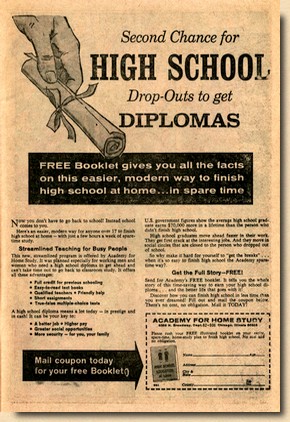 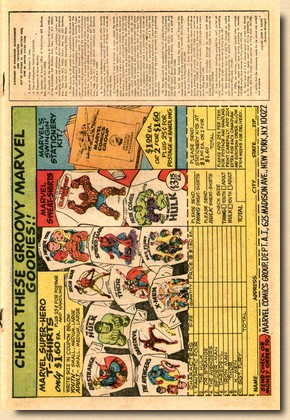
|
| |
|
| |
| A classic example are the "200 soldiers
sets" (also advertised in Tales Of Suspense #88):
the box turned out to be the cheapest cardboard you could
imagine, and the soldiers were absolutely flat (i.e.
almost two dimensional) and all in the same pose (as
described and illustrated by Demarais). Still, there are
some ads of interest, such as the Electronic Computer
Brain - remember, the year is 1966. On the whole,
however, readers considered ads a nuisance unless they
were in-house plugs for other titles (merchandising was
gradually taking off, but still in its infancy). |
| |
  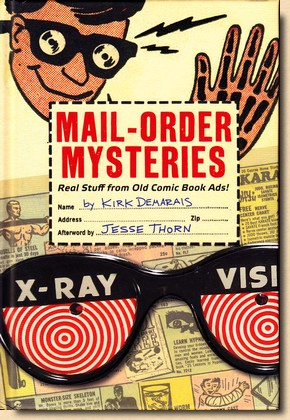
|
| |
| |
|
| |
| BIBLIOGRAPHY BUCHANAN
Bruce (2009) "Morbius the Living
Vampire", in Back Issue! #36
(October 2009)
COOKE Jon B. (1998) "Stan
the Man & Roy the Boy: A Conversation Between Stan
Lee and Roy Thomas", in Comic Book Artist #2,
Summer 1998
DEMARAIS Kirk (2011) Mail Order
Mysteries - Real Stuff from Old Comic Book Ads!,
Insight Editions
GRATH Gary
(1996) "Interview with Gil Kane, Part I", in Comics Journal #186
(April 1996)
LEE Stan (1972) "A special message from Stan Lee",
editorial published in UK Mighty World of Marvel #1
(30 September 1972)
NN
(2003) "Stan Lee Interview", contained as extra
feature on the double disk DVD release of the movie Daredevil
(personal transcript)
|
| |
| |
The
illustrations presented here are
copyright material.
Their reproduction for the review and
research purposes of this website is
considered fair use
as set out by the Copyright Act of 1976,
17 U.S.C. par. 107.

(c) 2021
|
|
|
|